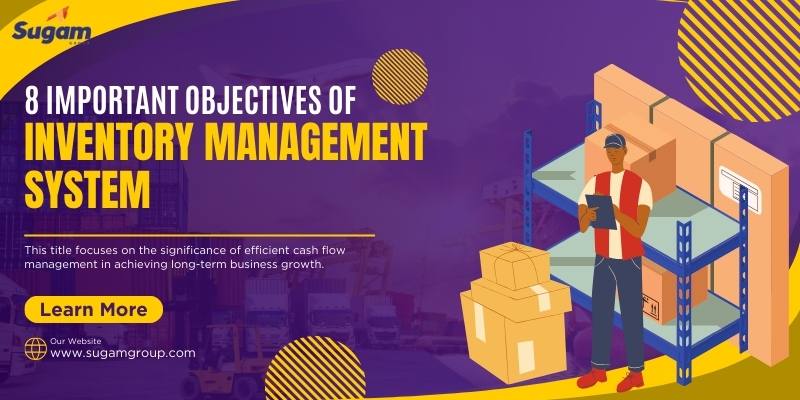8 Important Objectives of Inventory Management System
Efficient inventory management is the linchpin of operational success for businesses, especially for dynamic and growing entities like Sugam Group. In this comprehensive exploration, we will delve into the seven key objectives of Sugam Group’s inventory management system, dissecting each facet to understand how it significantly contributes to the company’s overall performance, ensuring sustainable growth in a competitive business landscape.
Objectives of Inventory Management System:
Inventory management serves as the choreographer in this performance, synchronising the need for an adequate supply of inventory to fulfil customer demand with the imperative to minimise unnecessary inventory and associated expenses. This article explores the dual lens through which inventory management enhances both operational efficiency and financial prudence.
The operational heartbeat of any business relies on the ability to meet customer demand seamlessly. Having an adequate supply of inventory is the linchpin of achieving this operational goal. Here’s how inventory management plays a pivotal role:
Material Availability:
At the heart of Sugam Group’s operational strategy lies the goal of ensuring the uninterrupted flow of materials for its diverse production processes. The proactive maintenance of a buffer stock for critical goods is not merely a precautionary measure; it’s a strategic imperative. This approach positions Sugam Group to swiftly adapt to market demands, preventing production slowdowns due to unforeseen resource shortages and fostering a distinctive competitive edge.
Better Level of Customer Service:
The nexus between accurate inventory counts and timely order fulfilment is a crucial determinant of Sugam Group’s commitment to delivering quality products. A robust inventory management system is the linchpin that ensures Sugam Group not only meets but exceeds customer expectations. By maintaining an optimal supply of completed products, Sugam Group not only secures customer trust but also elevates its brand image, reinforcing customer loyalty in a competitive market.
Keeping Wastage and Losses to a Minimum:
Inventory management serves as a formidable guardian against losses, addressing the inherent risks of waste and theft. The meticulous tracking of inventory minimises the chances of items being squandered or misplaced. In an industry where theft is an ever-present concern, vigilant inventory management provides a shield, offering protection against potential financial losses. By minimising wastage at every stage, from storage in godowns to production in the plant, Sugam Group ensures resource optimization and operational resilience.
Maintaining Sufficient Stock:
A seamless supply chain is indispensable for Sugam Group’s multifaceted operations. Ensuring a steady and easily accessible supply of materials for all production stages, from raw materials to finished goods, is paramount. This strategic assurance liberates the manufacturing department from concerns about potential resource shortages, allowing Sugam Group to navigate production challenges with confidence and meet client demands promptly.
Cost-Effective Storage:
Efficiency in inventory management translates into streamlined storage practices. The elimination of excess stock, driven by accurate needs predetermination, not only avoids unnecessary storage expenses but also contributes to a lean and cost-effective supply chain. Sugam Group, by embracing cost-effective storage through meticulous inventory management, not only optimises resource utilisation but also bolsters its bottom line.
Cost Value of Inventories Can Be Reduced:
Strategic and regular stock replenishment empowers Sugam Group to negotiate favorable terms, including discounts and incentives, with suppliers. This not only reduces the overall cost of purchasing products or stock but also enhances the financial health of the organisation. In a landscape where financial prudence is key, effective inventory management becomes a catalyst for sustained profitability.
Optimising Product Sales:
Inventory management is a dynamic tool for analysing and predicting product sales, a critical aspect of Sugam Group’s business strategy. Understanding current market conditions and making informed future assumptions are pivotal for success. By identifying slow-moving items through strategic inventory analysis, Sugam Group can proactively optimise sales, ensuring a dynamic product portfolio that maximises revenue and adapts to evolving market trends.
Specific Application to Sugam Group:
Sugam Group, a dynamic player in its industry, faces a distinctive set of challenges inherent to its unique landscape. The implementation of inventory management systems within this environment requires a nuanced approach, acknowledging the intricacies of the industry and the specific needs of Sugam Group. In navigating these challenges, Sugam Group not only showcases its commitment to operational excellence but also underscores its adaptability in crafting tailor-made solutions.
Implementation Challenges:
Sugam Group operates within a unique industry landscape, presenting specific challenges that demand tailor-made solutions in implementing inventory management systems. Addressing these challenges head-on not only demonstrates Sugam Group’s commitment to operational excellence but also ensures that its inventory management is finely tuned to the nuanced demands of its industry.
Tailoring Solutions to Seasonal Fluctuations:
The logistics sector experiences pronounced seasonality fluctuations that directly impact demand patterns. Sugam Group’s inventory management must navigate the ebbs and flows of consumer preferences during peak seasons and periods of lower demand. Implementing a system that can dynamically adjust inventory levels based on historical data and seasonal forecasts is crucial. This tailored solution ensures that Sugam Group can maintain an optimal balance between meeting heightened demand during peak seasons and preventing overstock during slower periods, contributing to cost efficiency and customer satisfaction.
Conclusion:
In essence, the eight objectives of inventory management are not theoretical concepts but pragmatic guidelines that wield significant influence over Sugam Group’s operational efficiency and overall success. By diligently adhering to these objectives – ensuring material availability, enhancing customer service, minimising wastage, maintaining sufficient stock, adopting cost-effective storage practices, reducing costs, and optimising product sales – Sugam Group positions itself as a formidable player in its industry. The implementation of a tailored inventory management system is not merely a business strategy for Sugam Group; it is a strategic imperative, a key driver for sustained growth and success in the dynamic business landscape in which Sugam Group operates. As Sugam Group navigates the complexities of its industry with agility and resilience, the importance of effective inventory management shines through as a beacon, guiding the company towards continued excellence and prosperity.





No Comments